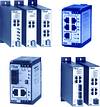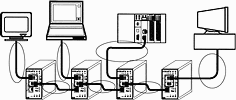
After having a look at speed and distance issues in Part II, we now turn our attention to a consideration between hubs vs switches.

Repeating hubs
Modern Ethernet networks must be wired in a star topology utilising either twisted-pair or fibre-optic cabling. Links, consisting of only two devices, are established between a single Ethernet device and a port on a hub. Hubs are multiport devices usually capable of having 4, 8 or 12 ports. Hubs can be cascaded with a hub-to-hub connection.
Repeating hubs must conform to the requirements for IEEE-802.3 repeater units. These requirements include preamble regeneration, symmetry and amplitude compensation. Repeaters must re-time signals so that jitter, introduced by transceivers and cabling, does not accumulate over multiple segments. These devices detect runt packets and react to collisions by generating a JAM signal. They automatically partition jabbering ports to maintain network operability.
A point to remember: there is a limit to the number of hubs that can be cascaded. Ethernet's contention-based station arbitration method requires that all stations note if a collision has occurred on the network. The limit of this detection is called the collision domain, and it restricts the network's overall size. Exceeding the collision domain by introducing too many repeating hubs creates an unstable network with lost messages and generally poor performance. However, on a properly designed network, repeating hubs are simple to understand and use, not to mention very effective.
Repeating hubs have been criticised because they do not improve the determinism of Ethernet. With contention-based networks, such as Ethernet, it is impossible to predict the amount of time it takes for a station-to-station message when collisions occur since the backoff time is variable. A potential solution to this problem is to avoid collisions altogether.
Industrial automation systems frequently utilise master/slave protocols where a response from a slave only occurs after a command is initiated by the master. This type of protocol tends to limit collisions and thereby improves determinism. Repeating hubs will function quite well in this situation.
Media converters
Another class of physical devices are the media converters. Sometimes called transceivers, these devices convert one type of media to another. The most important conversion is from twisted-pair cable to fibre optics. Since some hubs do not have any fibre-optic ports, media converters are required in order to support fibre-optic cable in a network. Media converters should appear to the network as transparent devices. They are two-port devices that do not store frames or detect collisions. They only convert the signals sent over one medium to compatible signals over another.
Switching hubs
It is possible to replace repeating hubs with switching hubs and achieve higher network performance. Unlike repeating hubs, which are physical layer devices, the switching hub is actually a bridge that connects two data links together. By doing so, collision domains terminate at each switch port. Therefore, adding a switch doubles the possible geographic limit of the network. Switches can be cascaded for an even larger network.
Switches are much more complex than repeating hubs. Each twisted-pair port automatically negotiates with its attached device the data rate for that port, be it 10 or 100 Mbps. The flow control mechanism is also negotiated. For full-duplex segments, the PAUSE scheme is used. For half-duplex segments, the backpressure approach is used. The switch learns the port locations of Ethernet devices by reading complete Ethernet frames and observing source addresses. The switch then creates and maintains a table of source addresses and corresponding port assignments. From that time on, traffic is restricted to only those ports involved in a transmission. This allows for improved throughput since simultaneous transmissions can be initiated on those ports without activity. Table values are aged to automatically accommodate changes to field wiring.
If a broadcast, multicast or unicast transmission to an unknown destination is received on a port, all other ports are flooded with the transmission.
In Figure 1 we have the same identical network as the preceding example except that all the repeating hubs have been replaced by switching hubs. The result is that instead of one overall collision domain we have several collision domains allowing us to have a much greater overall network diameter. Within each collision domain you must follow the same rules as stated earlier. You could add repeating hubs connected to switch ports. You could also make it easy on yourself by only specifying switching hubs and not repeating hubs. If you do that, the maximum twisted-pair segment length remains at 100 m; however, switches can be cascaded with little concern. If you want the same flexibility using fibre optics, we need to address the half-/full-duplex issue first.

Repeating hub vs switching hub debate
From the above discussion it would seem like switching hubs are an all-round best choice over repeating hubs. However, repeating hubs have their advantages. Repeating hubs are simple to understand and you can connect a network analyser to any transmission. A 'flood' port on the switch is required in order to observe all traffic on the network. Switching hubs are bridges that store and forward complete Ethernet frames, creating a degree of data latency. Cascading switches aggravate the problem. Therefore, you can see that repeating hubs, as well as switching hubs, have their place with industrial Ethernet.
Part IV will continue in a subsequent issue (10 September, 2002) and will look at half-duplex and full-duplex issues.
| Tel: | +27 12 493 0852 |
| Email: | [email protected] |
| www: | www.epd.co.za |
| Articles: | More information and articles about Electronic Products Design |

© Technews Publishing (Pty) Ltd | All Rights Reserved